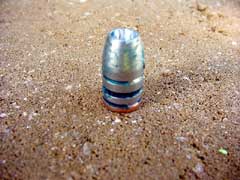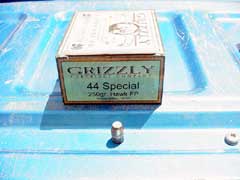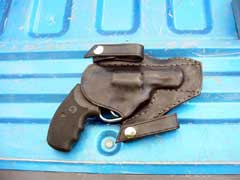|
Ed. Note: Mark Cassill is a Gunblast
member, and won the custom Charter 2000 Bulldog .44 revolver in
April 2004. He researched and wrote the following article using
his "Gunblast Bulldog". - Boge Quinn
  
Since winning the Charter
2000 Bulldog Pug
that Gunblast.com gave away this spring, I have faced the usual
quandary of those who pick a large-bore snubby for concealed
carry. Namely, which ammunition to use? Properly
loaded, the .44 Special should easily equal the excellent
performance of the .45 ACP. The one fly in the ointment is
that the short barrel may cause the loss of a good deal of
velocity, which could compromise bullet performance. I
select defense ammo by the following criteria: I want stuff that
works. Period. In the unfortunate event of having to
actually use a firearm on somebody in self-defense, my
overriding desire is to put the bad guy out of the fight as
quickly as possible. The longer the felon is still
standing, the more opportunity he would have to do harm to
myself or loved ones. Thus I want ammunition that does
major damage to whatever body parts it hits; a bullet that
expands quickly and creates a large permanent wound channel
through vital organs. Since I spend a fair amount of time
in urban areas, a bullet that exits is to be avoided, lest it
wound a bystander elsewhere.
The Bulldog Pug was well reviewed by Jeff Quinn here: http://www.gunblast.com/Bulldog_Pug.htm.
I found it much like Jeff did, as a well-built, reliable little
sidearm. Someday my shooting skills will get to the point
where I can duplicate the excellent groups that Jeff produced.
I typically do better with guns that have a longer sight radius
and adjustable sights; but as it is I have no problem keeping
all the shots within the torso of the Osama silhouette at 25
yards, offhand, double action even, with a variety of ammo.
In single-action mode offhand head shots are no problem at that
distance.
I gathered up boxes of all the .44 Special
factory loads I could find. Those include: the Hornady
180 grain jacketed hollow point, the Speer Gold Dot 200
gr. JHP, the Winchester Silvertip 200gr. JHP, the Federal
200 gr. swaged lead hollow point load, and a Grizzly
Cartridge Co. load using the 250 grain Hawk jacketed
flat point. At one time I had a box of Cor-Bon .44
Special; that has managed to get lost in a recent move, which is
unfortunate as I have not been able to locate more, and Cor-Bon
ammo has a reputation for working quite well.
Finally, since every scientific study needs a
"control", I elected to test one .45 ACP load.
For that I went with the Remington 230 grain Golden Saber
standard pressure load, which has a good track record in actual
shootings. This I fired from my "truck gun", a
Brazilian contract Smith and Wesson 1917 revolver.
In addition to these factory loads I put together two handloads
for testing. One used a Rainier 240 grain plated hollow
point loaded at +P pressure levels. I believe this
particular bullet was intended for use at .44 Magnum velocities;
it simply didn't work in this test. The other load
involved a batch of hollow point bullets which I cast in a Lyman
Devastator mould, using an alloy of 1-20 tin to lead. With
gas check and LBT lube this bullet weighed in at 267 grains, and
was also loaded with a +P charge of Hodgdon Universal.
Casting up this particular bullet is a bit of work; having done
a batch I can see why nobody offers cast hollow points on a
commercial basis. These should not to be confused with the
swaged lead bullets offered by various firms, which are usually
formed from pure lead or an alloy pretty close to that.
At this point I should mention that there are definite
limits on what the Bulldog should be fed. It is simply not
as stout as the big N-frame Smith & Wessons or other .44
Specials that are on the market. Some loads such as
the otherwise excellent "Heavy .44 Special" loads
offered by Buffalo Bore Ammunition or Elmer Keith's
famous hunting load (the 250 gr. Keith bullet over 16.7 grains
of Alliant 2400 in modern brass) are simply too hot for
the little Bulldog and will shoot one loose in short order.
Uncle Elmer's "all-purpose" load, the same 250 Keith
over 7.5 grains of Unique (I use Universal, which seems to have
an identical burning rate) is about as hot a load as I care to
fire in this piece, and even it only sparingly. This
particular load clocks 910 fps out of my Bulldog or 1030 fps out
of my 5.5" Freedom Arms model 97 and would be quite
adequate for many tasks outdoors. Recoil of this load is
much brisker than factory .44 Specials but quite manageable.
Then again, I shoot a .500 Linebaugh for fun, so your
perceptions about recoil might vary.
The test procedure was a fairly simple one. First I would
fire two rounds through a chronograph to get a velocity reading,
and then fire one round into a stack of wet newspaper.
Then the bullet was recovered from the stack and its penetration
depth measured. The wet paper is well-established to be a
reasonably close approximation to heavy muscle tissue. It
is also easy for the amateur ballistician to handle, unlike
ballistic gelatin, which is a pain to make up and an even bigger
pain to work with. In an actual body these bullets would
give double (or more) the penetration that they show in this
test media. All testing was performed in an Iowa cow
pasture at a temperature of ninety degrees; your mileage may
vary.
The first round tested was the Remington .45
"control". This round averaged 840 feet per
second and in the paper demonstrated a picture-perfect mushroom
while penetrating to a depth of eight inches. This is the
sort of performance we are seeking for our .44 Special carry
load.
The next load tested was the cast hollow point handload.
This one clocked 895 fps and penetrated a quarter-inch less than
the .45 load while expanding to about .74 caliber. The
recovered bullet weighs 265 grains; most excellent performance
by any standard. Recoil is just a bit brisk; if one wanted
an easier-shooting load it would be a simple matter to cast the
bullets from a softer alloy (say, 1-30) and reduce the powder
charge. With a bullet this heavy out of a gun this light a
good deal of muzzle flip is a given; follow-up shots will not
come as quickly as with the lighter factory loads. This
load does have the advantage of shooting to point-of-aim in my
particular revolver without the need to file the front sight.
I am aware that in some jurisdictions, actually shooting someone
with such a handload will get you branded in court as a mad
scientist type by some bottom-feeding attorney who files suit on
behalf of the "poor, innocent" deceased. The
reader would have to survey his particular area and understand
what sort of people he would have on a jury there before using
such ammo for self-defense. Such loads work; whether you
use them is your decision.
The next round tested was the plated hollow point handload.
This load clocked 736 fps, penetrated twelve inches and showed
no expansion whatsoever. This bullet clearly needs a lot
more velocity to work.
Next up is the Grizzly Cartridge Company load, and a learning
experience. This load clocked 840 fps and penetrated 15
inches while showing very minimal expansion. This load
(and all of the Grizzly offerings, for that matter) is tailored
for the needs of big game hunters and people living in bear
country. Having used one of their .45-70 loads on a recent
hunt for Corsican Ram and tested other loads in .475 and .500
Linebaugh, I can attest they work quite well for that. Mike
Rintoul, the proprietor of Grizzly Cartridge, tells me that
he has customers in Alaska carrying .44 Specials for bear
protection. This load might work reasonably well for that,
although I think I would prefer to be packing one of my larger
handguns (such as my custom Ruger Redhawk in .500
Linebaugh) for protection against irate grizzlies. In
calibers such as this you can make a load to work well either
for hunting or for personal defense against humans; you aren't
likely to come up with a load that does both well. This is
a perfect example of that.
The Federal swaged hollow point load, by any armchair analysis,
should have performed a lot better than it did. The dead
soft lead SHOULD expand like crazy. Unfortunately it
didn't. It averaged 792 fps and penetrated 13.5 inches
while showing minimal expansion. I suspect the hollow
point may have became plugged up with paper fiber, causing the
lack of expansion. Perhaps more velocity would have
helped, but then you may run into severe leading problems.
In any event, there are better choices.
The Speer Gold Dot load is more like what we're looking for.
It clocked 761 fps and penetrated six inches while mushrooming
beautifully. It also has fairly mild recoil for fast
follow-up shots. This load and other 200 grain loads shoot
about a foot low at 25 yards from my gun, but it is a simple
matter to file the front sight to make it shoot to point of aim.
The Winchester Silvertip also turned in excellent performance.
It clocked 784 fps and penetrated seven inches in the wet paper
while mushrooming all the way back to the base.
The last load tested was the Hornady 180 grain.
This load clocked 808 fps and penetrated 9 inches while
expanding to a little over bullet diameter. Just out of curiosity
I chronographed this load from the 5.5" tube of my FA 97
.44 Special; out of that gun it averages 941 feet per second.
This particular bullet would probably be greatly helped by the
added velocity.
It would appear that the person carrying a Bulldog for
self-defense would be well-served with the factory loads from
Speer or Winchester, or by the cast hollow-point load if he
wants something with more "thump". With any of
these choices you will have a very effective carry gun that
didn't break the bank.
Mark Cassill
  
Got something to say about this article? Want to agree (or
disagree) with it? Click the following link to go to the GUNBlast Feedback Page.
All content © 2004 GunBlast.com.
All rights reserved. |
|
Click pictures for a larger version.

The Gunblast Bulldog with the assortment of ammo tested
in it.

Lyman mould used to cast the "Devastator" cast
hollow point tested. The bullet seems quite capable of
living up to the name.

The Lyman cast hollow point after being sized, lubed, and the
gas check seated in place.

The author's testing set-up, out in an Iowa cow pasture.

A stack of wet newspaper is an easy way of testing your
bullets' effectiveness; it also is a good use for your local
liberal rag for those who don't have a birdcage to line.

This test included five different .44 factory loads, two
handloads, and a .45 ACP load used as a benchmark.

The Remington .45 ACP "control" load performed
as advertised.

The cast hollow point load is a very good performer
indeed.

The Rainier plated hollow point, on the other hand, just
doesn't work at the velocities obtained here.

The 250 grain Hawk bullet in this Grizzly Cartridge
Company load simply wasn't moving fast enough from the short
barrel to expand in paper; a good hunting bullet, isn't what
we're looking for here though.

The Federal swaged hollow point didn't work at all for
some reason.

The recovered Speer Gold Dot; it expanded to about .61
caliber. It would be interesting to load this bullet to
a higher velocity to see what would happen.

The recovered Winchester Silvertip; expansion to
.66 caliber with decent penetration. Couldn't ask for a
whole lot more.

The Hornady load would probably work better out of a
longer barrel that gives it more velocity. For our
purposes it does beat a sharp stick though.

The lineup of recovered bullets.


The author carries the Bulldog in an IWB holster made by
Rob Leahy. Simple, rugged, and very effective.
|
![]()